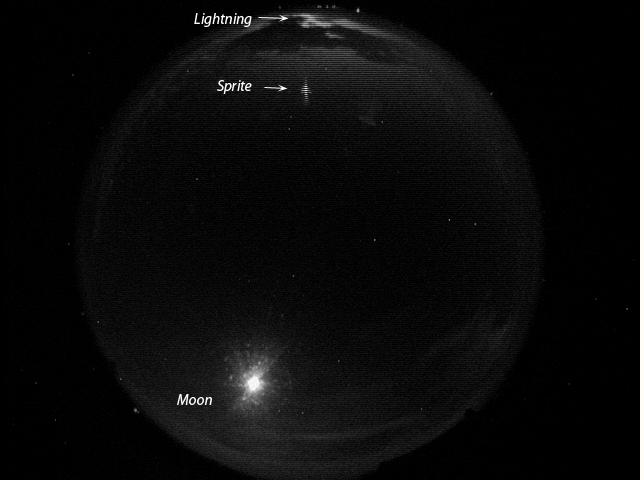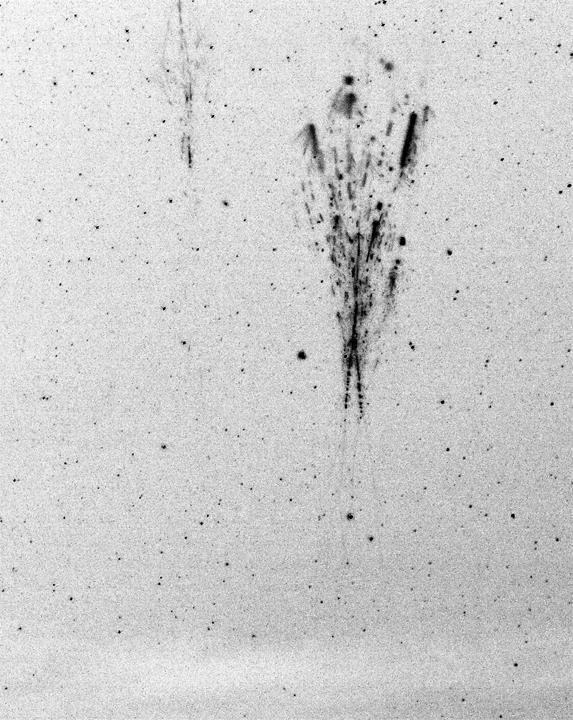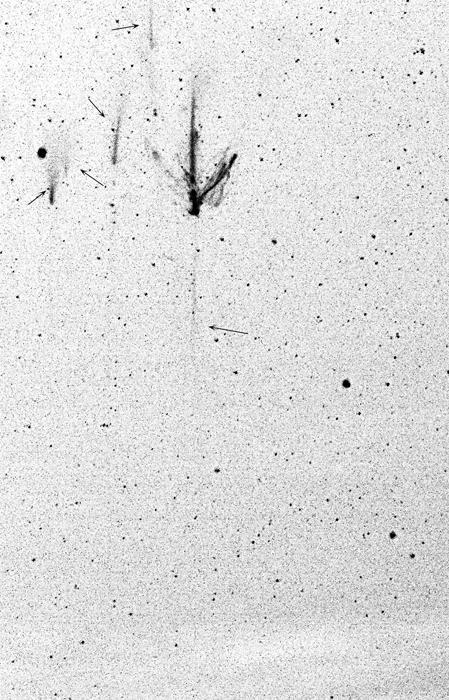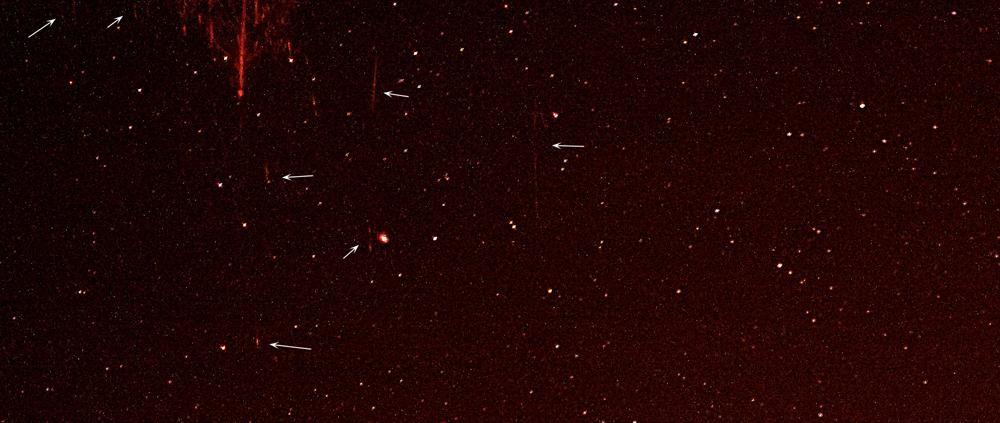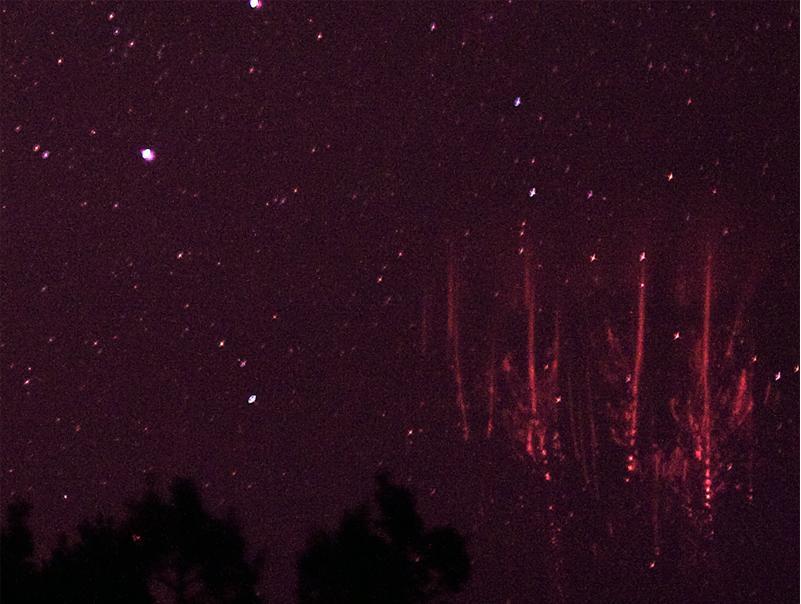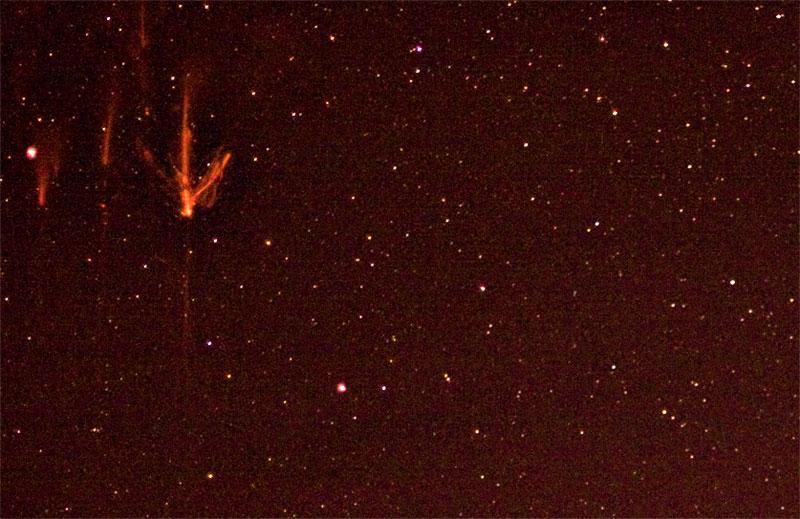 |
||
Above: Sprite cluster captured with a modified Canon XS DSLR ( Infrared filter removed). July 31, 2011. - Thomas Ashcraft NOTE: If you are entering my site from the Weather Channel or WeatherUnderground you will find more recent sprite images and a collection of videos here. Sprites Captured by Forward Scatter and Other Radio Methods Thomas Ashcraft Heliotown Mail I have been radio observing meteors and space dust since 1992 with a VHF forward scatter array and over the years I have become an optical meteor imager as well. In 2007, Sandia National Laboratories loaned me an experimental all-sky video camera system for visual fireball observations and I made the innovation of merging my radio meteor array with this special optical camera. It works extremely well and I have been recording visual fireballs with their radio reflections and emissions nightly since then. In 2010, I began to notice transient luminous events (TLEs) in the form of sprites in my all-sky night videos which occurred after certain lightning bolts. Perhaps the sprites were there in my earlier meteor observations but I was not consciously looking for them and they are very subtle, millisecond-quick and easy to overlook.
When I began to examine the sprites in my videos with high scrutiny I started to notice a pattern of associated radio sound in that some of them manifested a VHF forward scatter reflection "ping" much like meteors do. Here are three specimen sprite cluster movies and 61.250 MHz VHF forward scatter "pings" reflected off of a tv transmitter carrier wave broadcasting from Mexico: http://www.heliotown.com/SPvhfAug032010_044340ut_Ashcraft.mp4 http://www.heliotown.com/SPvhfAug032010_043347ut_Ashcraft.mp4 http://www.heliotown.com/SPvhfAug032010_045358ut_Ashcraft.mp4
Forward Scatter Observing For comparison, here is a meteor, in this case a large fireball, with a strong forward scatter radio reflection: http://www.heliotown.com/FBs20110417_074250utAshcraft.mp4 When meteors strike and enter Earth's atmosphere they make a cone or a "tube" of ionization and this ionization has the capability of reflecting VHF radio waves while it is coherent in the high sky. This has been well studied over the past decades and forward scatter observing is an established and now basic method in meteor science. Sprites also create a form of plasma ionization although it may differ from meteor ionization in that it is supposedly a cold plasma ( fluorescence?) rather than the hot plasma of meteors. In any case, the sprite ionization proves to be reflective of very high frequency radio waves. One of the reasons that sprites were not captured on images until 1989 is that visual observing conditions must be just right. The sprite spawning thunderstorm usually must be strong and at a far distance from the observer so that you can image above the thunderstorm cloud tops. It must be night and importantly there can't be intervening clouds obstructing line of sight between the observer and thunderstorm cloud tops. It is possible that forward scatter radio methods of sprite observing may be useful when visual conditions are poor. This is the great value of forward scatter radio meteor observing. Daylight, moonlight and clouds do not affect radio meteor observing and data can be collected 24 hours a day. If a forward scatter signature of sprites can be established then sprites may also be observed like meteors when they appear. Here is an example of a possible VHF radio sprite reflection through intervening cloud when it was not possible to see visual sprites. Note in the movie that first there is the lightning bolt emission followed by the "ping". ( NOTE: I stress the word "possible" in the following cases without absolute visual verification.) http://www.heliotown.com/LpingAug192010_0348.34.300_Ashcraft.mp4 Here is a brief medley of possible obscured transient luminous event specimens with forward scatter reflections: http://www.heliotown.com/SP_pingVHF_July262011medley_Ashcraft.mp4 There are other forms of transient luminous events called halos, elves, blue jets, and starters. Supposedly there are many more halo occurrences than sprites themselves and I am wondering if halos may have a specific signature as well. I believe this merits further study.
Sprite Captured at High Frequency and Very High Frequency on September 09, 2011 at 0401:52 UTC
The above sprite occurrence was captured over north central New Mexico with an experimental Sentinel all-sky camera and also on my VHF radio array at the frequencies of 61.250 MHz CW and 67.250 MHz CW and on my radio Jupiter array at the High Frequency of 21.1 MHz. This particular single sprite did not manifest a forward scatter reflection or in this case a back scatter reflection but its direct electromagnetic emission can be heard distinctly in the movie below. http://www.heliotown.com/SPSep092011_040152mag_Ashcraft.mp4
Medium Frequency Captures of Radio and Visual Sprites When I observe for TLEs I also record WWV radio time signals at 2.5 MHz in the video stream for precise time stamp. I am noting that sprites make a direct and distinct emission at this frequency range and here are a few specimens recorded in the midst of the WWV station signal. You will have to listen closely but the sprites are distinct. http://www.heliotown.com/SpAug042011_042028ut_Ashcraft.mp4 NOTE: The next two specimens are recorded a little loud. Please adjust your volume lower especially if using headphones. http://www.heliotown.com/SPJuly312011_052904ut_Ashcraft.mp4 http://www.heliotown.com/SpJuly312011_052423ut_Ashcraft.mp4
VLF-ELF Direct Radio Emission from Sprites Sprites and their parent lightning discharges generate direct radio emissions at very low and extremely low frequencies. This has been the subject of numerous observing campaigns and various papers on sprites and VLF radio can be accessed on the internet. Here are two specimens captured with a McGreevy WR3-E VLF receiver: http://www.heliotown.com/SpJune162010_090011mag_Ashcraft.mp4 http://www.heliotown.com/Transient_Luminous_Events.html
Visual Observing I reside in the state of New Mexico in the southwest United States where there is a high incidence of lightning. Usually lightning is a major hassle in radio astronomy and has me unplugging my radio systems for good reason. But lightning is also thrilling and beautiful and I am learning to appreciate it in new ways. At the moment I have two separate video observing systems and I recently acquired a modified Canon XS DSLR camera with the infrared filter removed and replaced with a clear full spectrum filter which has good sensitivity in the 600 nm to 900 nm wavelength range where sprites are most visible. On July 31, 2011, I was able to capture three separate sprite clusters above a storm near Clovis, New Mexico about one hundred miles away. Here are some image details:
.... Here is an image detail of a sprite cluster that occurred over the panhandle of western Oklahoma on September 22, 2011 at 0657:05 UTC.
Ongoing Research Transient luminous events are a hot topic in science these days and there will be further discoveries in the future. They are part of the Earth's natural electrical system and may play an electro-chemical role in global warming. They are studied at many radio wavelengths but I have not found any papers mentioning VHF forward scatter observations. Whereas forward scatter observing may be challenging in some ways, it can be done and may prove useful in observing TLEs when other methods are impractical. Listen close and you might just hear (and distinguish) a sprite on your car radio someday. Clear skies, Thomas Ashcraft New Mexico : Mail : url: www.heliotown.com More sample visible sprite and scatter specimens here: |
||
